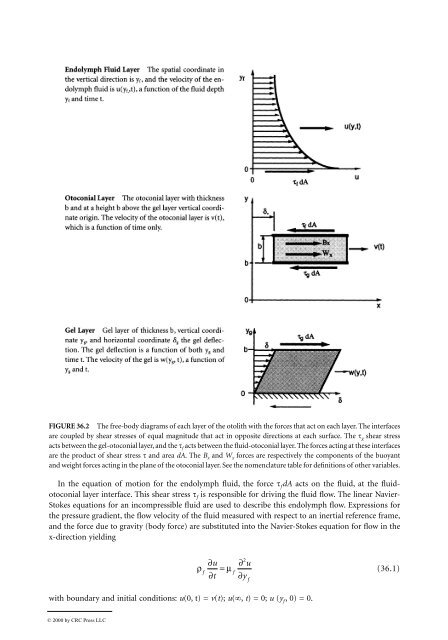chapter 36 - Vestibular Mechanics - KEMT FEI TUKE
chapter 36 - Vestibular Mechanics - KEMT FEI TUKE
chapter 36 - Vestibular Mechanics - KEMT FEI TUKE
You also want an ePaper? Increase the reach of your titles
YUMPU automatically turns print PDFs into web optimized ePapers that Google loves.
FIGURE <strong>36</strong>.2 The free-body diagrams of each layer of the otolith with the forces that act on each layer. The interfaces<br />
are coupled by shear stresses of equal magnitude that act in opposite directions at each surface. The τ g shear stress<br />
acts between the gel-otoconial layer, and the τ f acts between the fluid-otoconial layer. The forces acting at these interfaces<br />
are the product of shear stress τ and area dA. The B x and W x forces are respectively the components of the buoyant<br />
and weight forces acting in the plane of the otoconial layer. See the nomenclature table for definitions of other variables.<br />
In the equation of motion for the endolymph fluid, the force τ fdA acts on the fluid, at the fluidotoconial<br />
layer interface. This shear stress τ f is responsible for driving the fluid flow. The linear Navier-<br />
Stokes equations for an incompressible fluid are used to describe this endolymph flow. Expressions for<br />
the pressure gradient, the flow velocity of the fluid measured with respect to an inertial reference frame,<br />
and the force due to gravity (body force) are substituted into the Navier-Stokes equation for flow in the<br />
x-direction yielding<br />
with boundary and initial conditions: u(0, t) = v(t); u(∞, t) = 0; u (y f, 0) = 0.<br />
© 2000 by CRC Press LLC<br />
2<br />
∂u<br />
∂ u<br />
=µ<br />
∂ t ∂y<br />
ρ f f<br />
f<br />
(<strong>36</strong>.1)








